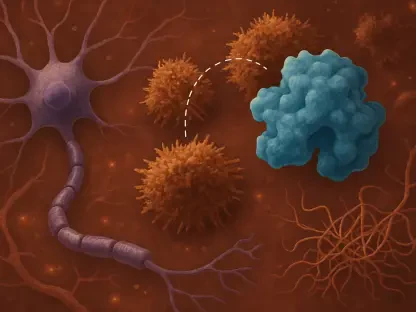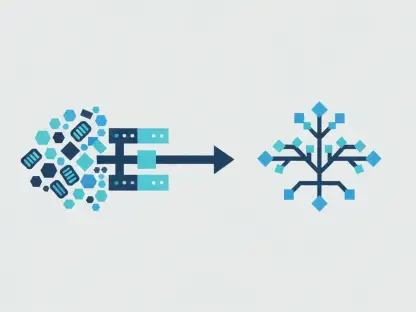A groundbreaking study led by Natasha Chang at McGill University has shown that a novel drug, K884, holds promise for treating Duchenne muscular dystrophy (DMD), a devastating genetic disorder characterized by severe muscle degeneration. Unlike conventional treatments, which primarily focus on slowing the progression of muscle damage, K884 represents a significant advancement because it enhances the natural repair mechanisms of muscle stem cells. This discovery could fundamentally change the landscape of DMD treatments, offering a glimmer of hope for improved quality of life for those afflicted by this disease.
Duchenne muscular dystrophy predominantly affects boys, with approximately one in 5,000 male births worldwide diagnosed with the condition. Early symptoms often manifest in childhood, leading to the progressive weakening of muscles. Many patients become wheelchair-dependent by adolescence and face severe health complications in early adulthood. Current treatments offer limited relief, focusing on delaying the disease’s progression without addressing its underlying cause. K884’s specific targeting of muscle repair rather than merely mitigating muscle damage offers a crucial paradigm shift in DMD management.
The Mechanism of K884
Enhancing Muscle Stem Cell Function
The most intriguing aspect of K884 is its ability to enhance the natural repair functions of muscle stem cells. Muscle stem cells are vital for muscle regeneration and repair, and in DMD patients, these cells often fail to function correctly. The research led by Natasha Chang revealed that K884 could significantly bolster the activity of these essential cells. The drug works by blocking specific enzymes that interfere with the transformation of muscle stem cells into functional muscle tissue. This mechanism ensures that the drug selectively targets DMD-affected cells, sparing healthy muscle stem cells, a critical feature that minimizes potential side effects.
In DMD patients, the absence of the dystrophin protein disrupts the integrity of muscle fibers, causing them to be more susceptible to damage. By enhancing the function of muscle stem cells, K884 helps to restore the muscle repair processes that are typically hampered in these patients. This approach not only addresses the symptoms but potentially modifies the disease’s progression by restoring the body’s natural ability to heal and maintain muscle tissue. This discovery underscores the importance of muscle stem cell function in managing muscular dystrophies and points to new therapeutic strategies that could transform patient care.
A Broadly Applicable Treatment
Another noteworthy feature of K884 is its broad applicability across different DMD patients. Unlike gene therapies, which often target specific genetic mutations and may not be suitable for all individuals, K884 operates at the cellular level. This cellular approach means that K884 could be effective for DMD patients regardless of the specific genetic mutation responsible for their condition. This versatility makes K884 a highly promising candidate for widespread clinical application, offering hope to a broader patient demographic.
The drug’s development was originally intended for cancer and metabolic diseases, with Kanyr Pharma initially focusing on these areas. However, this study marks the first evaluation of K884 in DMD-affected cells, opening new avenues for research and treatment. By selectively targeting the affected muscle stem cells, K884 has demonstrated efficacy in preliminary studies, providing a foundation for further exploration. The ability to enhance muscle repair across various mutations sets K884 apart from other therapies and underscores its potential as a universal treatment for DMD.
Future Directions for K884 and DMD Treatment
Further Testing and Safety Assessments
Moving forward, the research team plans to conduct extensive testing of K884 to assess its safety and long-term effects. These steps are crucial to determine the drug’s viability for clinical use and to ensure that potential side effects are minimal. The current findings, although promising, represent only the initial phase of drug evaluation. Comprehensive trials will be necessary to fully understand how K884 functions over extended periods and under varying conditions in patients. The research supported by institutions such as the Stem Cell Network and Defeat Duchenne Canada aims to build a robust body of evidence supporting K884’s efficacy and safety.
Exploring related compounds is another avenue the researchers are pursuing. Some of these compounds have already entered early human trials, showing that the scientific community is moving quickly to translate these findings into potential treatments. The collaborative efforts between different research institutions and organizations highlight the commitment to advancing DMD treatment options. These efforts not only focus on K884 but also seek to identify and develop other therapeutic agents that could work synergistically to optimize patient outcomes.
Implications for Understanding DMD
These groundbreaking findings suggest that K884 could pave the way for new treatments and management strategies for Duchenne muscular dystrophy. By enhancing the body’s natural muscle repair processes, the drug could provide a more effective treatment option, transforming the lives of those affected by this debilitating condition. Further research and clinical trials will be critical in affirming K884’s place in the future of DMD therapy.









